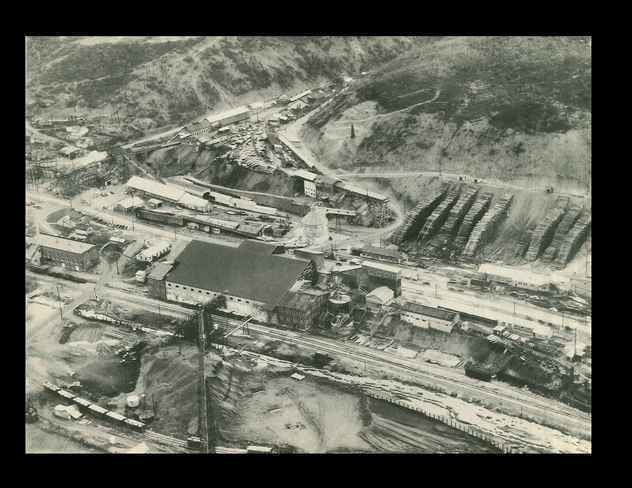 | ||
The Bunker Hill Mine and Smelting Complex ("Bunker Hill smelter"), was a large smelter located in Kellogg, Idaho, in the Coeur d'Alene Basin. When built, it was the largest smelting facility in the world. It is located in what became known as the Silver Valley of the Coeur d'Alene Basin, an area for a century that was a center of extensive silver and other metal mining and processing. This resulted in extensive contamination of water, land and air, endangering residents including the Coeur d'Alene Tribe, which had traditionally depended on fish from the waterways as part of its subsistence.
Contents
- HistoryEdit
- Labor organizingEdit
- Environmental issuesEdit
- Coeur dAlene 1991 Lawsuit for damages and cleanupEdit
- References
In 1983 the United States Environmental Protection Agency added this area to the National Priorities List as a Superfund site for investigation and cleanup. In 1991 the Coeur d'Alene Tribe filed suit against the mining companies for damages and cleanup costs; they were joined by the United States in 1996 and the state of Idaho in 2011. Settlement was reached with the two major defendants in 2008 and 2011, with an agreement for funding of $263.4 million plus interest for cleanup and restoration of habitat.
HistoryEdit
In the late 1880s, a boom in mining activity in Idaho's Silver Valley followed the construction of railroad lines through what was previously considered by European Americans to be inaccessible "wilderness." The area for centuries had been occupied as part of more than 3 million acres of territory controlled by the Coeur d'Alene Tribe.
The Bunker Hill mine, the largest of the Coeur d'Alene area mines, was founded after discovery of silver here in 1885 by Noah Kellogg. Initially, the ore was shipped out of the Silver Valley by train for processing; but within a few years, mills were built on-site to extract the metals from the ore. The process used by the first mills, known as "jigging," was very inefficient, often recovering less than 75% of the metal from the ore. This meant that large amounts of lead and other metals remained in the tailings, which were dumped in nearby waterways. In 1945, in the last months of World War II, the company added a cadmium-processing facility to the smelter, which recovered high-grade cadmium from the smelter's waste products.
Labor organizingEdit
For years Bunker Hill, like other mines in the region, was the site of intense struggles between regional miners' unions and mine owners/managers. The owners of the Bunker Hill mine organized with other mine owners to form the Mine Owners Protective Association in order to fight the unions. The Bunker Hill owners repeatedly refused to meet or negotiate with union representatives, leading to regular community protests. On April 29, 1899, during a union demonstration, a group of workers hijacked a Union Pacific train in Burke, Idaho and took it to Wardner. After a firefight with the Bunker Hill security guards, they dynamited the Bunker Hill and Sullivan ore concentrator, which was valued at $250,000.
Environmental issuesEdit
Many of the mine tailings were dumped directly into the Coeur d'Aléne River and its tributaries, which became polluted with high levels of sulfur dioxide, lead, and other metals. The water in the river turned opaque gray, earning the stream the nickname "Lead Creek." An estimated 100 million tons of arsenic, cadmium, and zinc were released into the air, along with 30,000 tons of lead. During the 1970s, when the smelter was still operating, children living in nearby areas began displaying very high blood lead levels. Approximately 26% of the two-year-olds in the region had dangerously high levels of lead in their blood, which had long-term negative consequences for their health, especially intellectual functioning and achievement.
In 1983, the Bunker Hill smelter was added to the National Priorities List as a Superfund site by the United States Environmental Protection Agency. As of 2007, the EPA had spent $200 million attempting to remediate the site, much of which was spent removing contaminated topsoil from residential areas. The state of Idaho had also spent funds since the early 1980s on cleanup. While there were measurable improvements in environmental conditions, a vast amount of cleanup and restoration was still required.
Coeur d'Alene 1991 Lawsuit for damages and cleanupEdit
In 1991 the Coeur d'Alene Tribe, concerned that progress was too slow at the Superfund site, brought suit against Hecla Mining Company, ASARCO and other companies for damages and recovery of cleanup costs of the site. In 1996 it was joined by the United States in the suit. In 2001 the United States and the Coeur d'Alene litigated a 78-day trial against Hecla and ASARCO over liability issues. In 2008, ASARCO, the other major defendant, reached settlement with the Coeur d'Alene and United States after filing for Chapter 11 bankruptcy.
In 2011 the government, the Coeur d'Alene, and the state of Idaho (which joined the suit to participate in settlement) reached settlement with the Hecla Mining Company to resolve one of the largest cases ever filed under the Superfund statute. Hecla Mining Company will pay $263.4 million plus interest to the United States and other parties to "resolve claims stemming from releases of wastes from its mining operations. Settlement funds will be dedicated to restoration and remediation of natural resources in the Coeur d’Alene Basin." The trustees intend to restore habitat for fish, birds and other natural resources, for stewardship while working for economic progress in the region.
